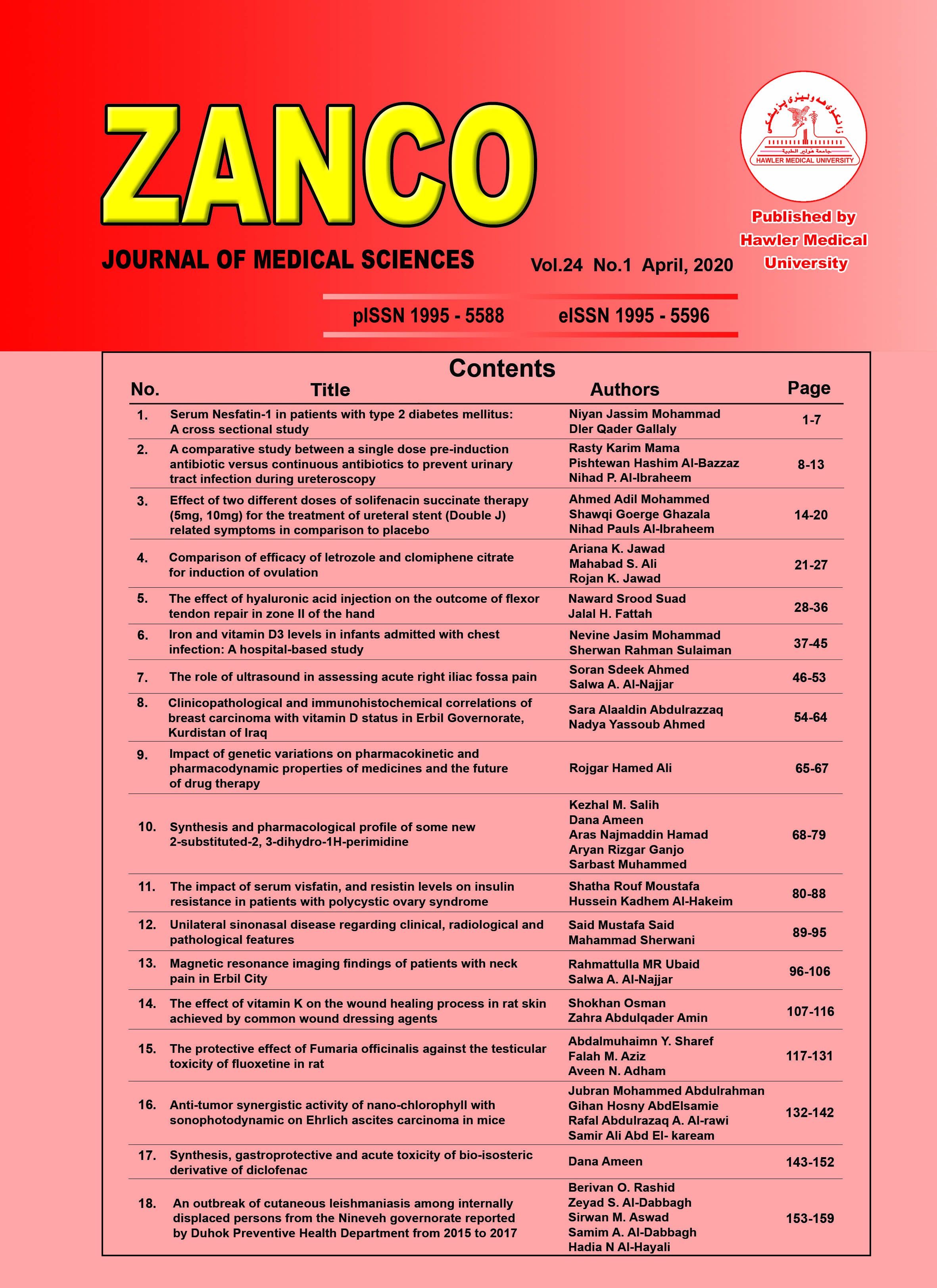Copyright (c) 2020 Niyan Jassim Mohammad, Dler Qader Gallaly (Author)

This work is licensed under a Creative Commons Attribution-NonCommercial-ShareAlike 4.0 International License.
- Articles
- Submited: June 1, 2020
-
Published: April 30, 2020
Abstract
Background and objective: Nesfatin-1 is a newly described peptide, derived from nucleobindin2. Nesfatin-1 suppresses food intake and it is involved in regulating insulin secretion. The aim of this study was to compare serum levels of Nesfatin-1 in patients having type 2 diabetes and non-diabetic subjects.
Methods: This cross-sectional study included 90 participants; 64 patients with type 2 diabetes mellitus (32 males and 32 females) and 26 control subjects (13 males and 13 female). Body mass index, fasting serum level of glucose, fasting serum level of insulin, and glycated hemoglobin were estimated. Homeostasis model assessment of insulin resistance was calculated. Nesfatin-1 level was measured using enzyme-linked immune-sorbent assay kit. The data was analyzed using Graphpad prism 7.04 for windows.
Results: Type 2 diabetes patients aged from 33-78 years and the control group aged from 32-75 years. Nesfatin-1 level in the diabetic group was significantly lower than controls. The median interquartile range (IQR) of Nesfatin-1 was 0.765 (0.4-1.173) in diabetes and 1.02 (0.775-1.458) in controls. The diabetes group has significantly higher homeostasis model assessment of insulin resistance compared with non-diabetics. Serum Nesfatin-1 was correlated negatively with body mass index, fasting serum glucose, fasting serum insulin, glycatedhemoglobin, and homeostasis assessment of insulin resistance.
Conclusion: Serum Nesfatin-1 level is negatively correlated with fasting serum glucose, fasting serum insulin, and glycated hemoglobin. This association supports the role of Nesfatin-1 in increased insulin resistance in patients with type 2 diabetes.
Metrics
References
- Oh-I S, Shimizu H, Satoh T, Okada S, Adachi S, Inoue K, et al. Identification of nesfatin-1 as a satiety molecule in the hypothalamus. Nature 2006; 443(7112):709–12.
- Butler AA. More news about NUCB2/Nesfatin-1: A new factor in the hypothalamic control of glucose homeostasis. Diabetes2012; 61(8):1920–2.
- Aydin S. Role of NUCB2/nesfatin-1 as a possible biomarker. Current Pharmaceutical Design 2013; 19(39):6986–92.
- Zhang Z, Li L, Yang M, Liu H, Boden G, Yang G. Increased plasma levels of Nesfatin-1 in patients with newly diagnosed type 2 diabetes mellitus. Exp Clin Endocrinol Diabetes 2012; 120(02):91–5.
- Ayada C, Toru U, Korkut Y. Nesfatin-1 and its effects on different systems. Hippokratia 2015; 19(1):4–10.
- Stengel A, Mori M, Tache Y. The role of nesfatin-1 in the regulation of food intake and body weight – recent developments and future endeavors Andreas. Obes Rev 2013; 14(11):859–70.
- Prinz P, Teuffel P, Lembke V, Kobelt P, Goebel-Stengel M, Hofmann T, et al. Nesfatin-130-59 injected intracerebroventricularly differentially affects food intake microstructure in rats under normal weight and diet-induced obese conditions. Front Neurosci 2015; 9:422.
- García-Galiano D, Navarro VM, Gaytan F, Tena-Sempere M. Expanding roles of NUCB2/nesfatin-1 in neuroendocrine regulation. J Mol Endocrinol 2010; 45(5):281–90.
- Khalili S, Khaniani MS, Afkhami F, Derakhshan MS. NUCB2/Nesfatin-1: A potent meal regulatory hormone and its role in diabetes. EJMHG 2017; 18(2):105–9.
- Shimizu H, Oh-I S, Hashimoto K, Nakata M, Yamamoto S, Yoshida N, et al. Peripheral administration of nesfatin-1 reduces food intake in mice: The leptin-independent mechanism. Endocrinology 2009; 150(2):662–71.
- Stengel A, Goebel M, Wang L, Rivier J, Kobelt P, Mönnikes H, et al. Central nesfatin-1 reduces dark-phase food intake and gastric emptying in rats: Differential role of corticotropin-releasing factor 2 receptor. Endocrinology 2009; 150(11):4911–9.
- Yoshimura M, Matsuura T, Ohkubo J, Maruyama T, Ishikura T, Hashimoto H. A role of nesfatin-1/NucB2 in dehydration-induced anorexia. Am J Physiol Regul Integr Comp Physiol 2014; 307(2):225–36.
- Pan W, Hsuchou H, Kastin AJ. Nesfatin-1 crosses the blood-brain barrier without saturation. Peptides 2007; 28(11):2223–8.
- Dore R, Levata L, Lehnert H, Schulz C. Nesfatin-1: Functions and physiology of a novel regulatory peptide. J Endocrinol 2017; 232(1):45–65.
- Song Y, Manson JE, Tinker L, Howard BV, Kuller LH, Nathan L, et al. Insulin sensitivity and insulin secretion determined by homeostasis model assessment and risk of diabetes in a multiethnic cohort of women: The women’s health initiative observational study. Diabetes Care 2007; 30(7):1747–52.
- Salgado AL, Carvalho LD, Oliveira AC, Santos VN, Vieira JG, Parise ER. Insulin resistance index (HOMA-IR) in the differentiation of patients with non-alcoholic fatty liver disease and healthy individuals. Arq Gastroenterol 2010;47(2):165–9.
- Li Z, Gao L, Tang H, Yin Y, Xiang X, Li Y, et al. Peripheral effects of Nesfatin-1 on glucose homeostasis. PLoS One 2013; 8(8):e71513.
- WHO. Definition and diagnosis of diabetes mellitus and intermediate hyperglycemia. Geneva: WHO; 2006.
- Algul S, Ozkan Y, Ozcelik O. Serum nesfatin-1 levels in patients with different glucose tolerance levels. Physiol Res 2016; 65(6):979–85.
- DeFronzo RA, Ferrannini E, Groop L, Henry RR, Herman WH, Holst JJ, et al. Type 2 diabetes mellitus. Nat Rev Dis Primers 2015; 1:15019.
- World Medical Association Declaration of Helsinki. Ethical Principles for Medical Research Involving Human Subjects. Bulletin WHO 2001; 79(4):373–4.
- Li F, He H. Assessing the accuracy of diagnostic tests. Shanghai Arch Psychiatry 2018; 30(3):207.
- Hinkle DE, Wiersma W, Jurs SG. Applied Statistics for the Behavioral Sciences. 5th ed. Boston: Houghton Mifflin; 2003.
- Liu F, Yang Q, Gao N, Liu F, Chen S. Decreased plasma nesfatin-1 level is related to the thyroid dysfunction in patients with type 2 diabetes mellitus. J Diabetes Res 2014; 2014.
- Tsuchiya T, Shimizu H, Yamada M, Osaki A, Oh-I S, Ariyama Y, et al. Fasting concentrations of nesfatin-1 are negatively correlated with body mass index in non-obese males. Clin Endocrinol 2010; 73(4):483–90.
- Ozturk CC, Oktay S, Yuksel M, Akakin D, Yarat A, Cakir KO. Anti-Inflammatory effects of nesfatin-1 in rats with acetic Acid-Induced colitis and underlying mechanisms. J Physiol Pharmacol 2015; 66(5):741–50.
- Zhai T, Li SZ, Fan XT, Tian Z, Lu XQ, Dong J. Circulating Nesfatin-1 levels and type 2 diabetes: A systematic review and meta-analysis. J Diabetes Res 2017; 2017:7687098.





